Investigating the Global Performance of the BDS-2 and BDS-3 Joint Real-Time Undifferenced and Uncombined Precise Point Positioning Using RTS Products from Different Analysis Centers
Abstract
1. Introduction
2. Methods
2.1. RTS Orbits and Clocks Recovery
2.2. Quality Assessment of Recovered RTS Orbits and Clocks
2.3. BDS-2 and BDS-3 Joint Real-Time Undifferenced and Uncombined PPP
3. Experiment Datasets and Processing Strategies
3.1. Experiment Datasets
3.2. Processing Strategies
4. Results and Discussions
4.1. Accuracy Analysis of RTS Products from Different ACs
4.2. Performance of BDS-2 and BDS-3 Joint Real-Time Undifferenced and Uncombined PPP in Static Mode
4.3. Performance of BDS-2 and BDS-3 Joint Real-Time Undifferenced and Uncombined PPP in Kinematic Mode
5. Conclusions
Author Contributions
Funding
Data Availability Statement
Acknowledgments
Conflicts of Interest
References
- Ge, Y.; Chen, S.; Wu, T.; Fan, C.; Qin, W.; Zhou, F.; Yang, X. An analysis of BDS-3 real-time PPP: Time transfer, positioning, and tropospheric delay retrieval. Measurement 2021, 172, 108871. [Google Scholar] [CrossRef]
- Liu, T.; Zhang, B.; Yuan, Y.; Li, M. Real-Time Precise Point Positioning (RTPPP) with raw observations and its application in real-time regional ionospheric VTEC modeling. J. Geod. 2018, 92, 1267–1283. [Google Scholar] [CrossRef]
- Wang, D.; Huang, G.; Du, Y.; Zhang, Q.; Bai, Z.; Tian, J. Stability analysis of reference station and compensation for monitoring stations in GNSS landslide monitoring. Satell. Navig. 2023, 4, 29. [Google Scholar] [CrossRef]
- Kouba, J.; Héroux, P. Precise point positioning using IGS orbit and clock products. GPS Solut. 2001, 5, 12–28. [Google Scholar] [CrossRef]
- Chen, J.; Li, H.; Wu, B.; Zhang, Y.; Wang, J.; Hu, C. Performance of real-time precise point positioning. Mar. Geod. 2013, 36, 98–108. [Google Scholar] [CrossRef]
- Elsobeiey, M.; Al-Harbi, S. Performance of real-time precise point positioning using IGS real-time service. GPS Solut. 2016, 20, 565–571. [Google Scholar] [CrossRef]
- Hadas, T.; Bosy, J. IGS RTS precise orbits and clocks verification and quality degradation over time. GPS Solut. 2015, 19, 93–105. [Google Scholar] [CrossRef]
- Li, B.; Ge, H.; Bu, Y.; Zheng, Y.; Yuan, L. Comprehensive assessment of real-time precise products from IGS analysis centers. Satell. Navig. 2022, 3, 12. [Google Scholar] [CrossRef]
- Yu, C.; Zhang, Y.; Chen, J.; Chen, Q.; Xu, K.; Wang, B. Performance Assessment of Multi-GNSS Real-Time Products from Various Analysis Centers. Remote Sens. 2023, 15, 140. [Google Scholar] [CrossRef]
- CSNO. Development of the BeiDou Navigation Satellite System (Version 4.0); CSNO: Sacramento, CA, USA, 2019. [Google Scholar]
- Liu, P.; Ling, K.; Qin, H.; Liu, T. Performance analysis of real-time precise point positioning with GPS and BDS state space representation. Measurement 2023, 215, 112880. [Google Scholar] [CrossRef]
- Liu, T.; Yuan, Y.; Zhang, B.; Wang, N.; Tan, B.; Chen, Y. Multi-GNSS precise point positioning (MGPPP) using raw observations. J. Geod. 2017, 91, 253–268. [Google Scholar] [CrossRef]
- Li, X.; Han, X.; Li, X.; Liu, G.; Feng, G.; Wang, B.; Zheng, H. GREAT-UPD: An open-source software for uncalibrated phase delay estimation based on multi-GNSS and multi-frequency observations. GPS Solut. 2021, 25, 66. [Google Scholar] [CrossRef]
- Tu, R.; Zhang, P.; Zhang, R.; Liu, J.; Lu, X. Modeling and performance analysis of precise time transfer based on BDS triple-frequency un-combined observations. J. Geod. 2019, 93, 837–847. [Google Scholar] [CrossRef]
- Wang, A.; Zhang, Y.; Chen, J.; Wang, H. Improving the (re-)convergence of multi-GNSS real-time precise point positioning through regional between-satellite single-differenced ionospheric augmentation. GPS Solut. 2022, 26, 39. [Google Scholar] [CrossRef]
- Wang, A.; Chen, J.; Zhang, Y.; Meng, L.; Wang, B.; Wang, J. Evaluating the impact of CNES real-time ionospheric products on multi-GNSS single-frequency positioning using the IGS real-time service. Adv. Space Res. 2020, 66, 2516–2527. [Google Scholar] [CrossRef]
- Liu, Y.; Yang, C.; Zhang, M. Comprehensive analyses of PPP-B2b performance in China and surrounding areas. Remote Sens. 2022, 14, 643. [Google Scholar] [CrossRef]
- Wang, A.; Zhang, Y.; Chen, J.; Wang, H.; Yuan, D.; Jiang, J.; Zhang, Z. Investigating the contribution of BDS-3 observations to multi-GNSS single-frequency precise point positioning with different ionospheric models. Adv. Space Res. 2024, 73, 553–570. [Google Scholar] [CrossRef]
- Xu, Y.; Yang, Y.; Li, J. Performance evaluation of BDS-3 PPP-B2b precise point positioning service. GPS Solut. 2021, 25, 142. [Google Scholar] [CrossRef]
- Zhou, F.; Dong, D.; Li, P.; Li, X.; Schuh, H. Influence of stochastic modeling for inter-system biases on multi-GNSS undifferenced and uncombined precise point positioning. GPS Solut. 2019, 23, 59. [Google Scholar] [CrossRef]
- Jiao, G.; Song, S.; Jiao, W. Improving BDS-2 and BDS-3 joint precise point positioning with time delay bias estimation. Measur. Sci. Technol. 2020, 31, 025001. [Google Scholar] [CrossRef]
- Su, K. BDS pseudorange biases handling: Simultaneous estimation, daily magnitude and analytical comparison of the BDS PPP models. Adv. Space Res. 2023, 71, 4681–4690. [Google Scholar] [CrossRef]
- Zhang, Y.; Kubo, N.; Chen, J.; Wang, A. Calibration and analysis of BDS receiver-dependent code biases. J. Geod. 2021, 95, 43. [Google Scholar] [CrossRef]
- Zhang, Y.; Chen, J.; Gong, X.; Chen, Q. The update of BDS-2 TGD and its impact on positioning. Adv. Space Res. 2020, 65, 2645–2661. [Google Scholar] [CrossRef]
- Chen, H.; Niu, F.; Su, X.; Geng, T.; Liu, Z.; Li, Q. Initial Results of Modeling and Improvement of BDS-2/GPS Broadcast Ephemeris Satellite Orbit Based on BP and PSO-BP Neural Networks. Remote Sens. 2021, 13, 4801. [Google Scholar] [CrossRef]
- Li, B.; Zang, N.; Ge, H.; Shen, Y. Single-frequency PPP models: Analytical and numerical comparison. J. Geod. 2019, 93, 2499–2514. [Google Scholar] [CrossRef]
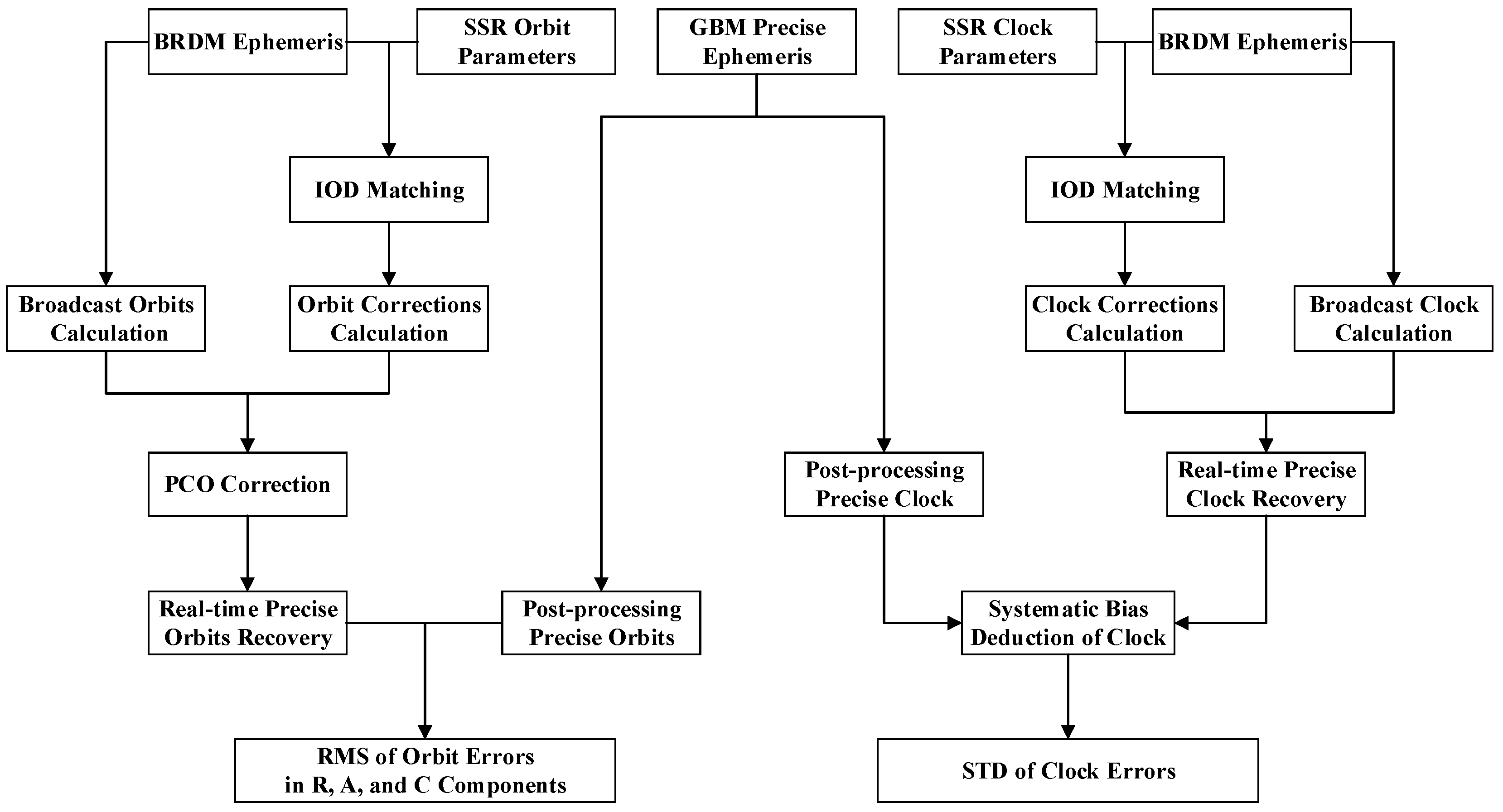

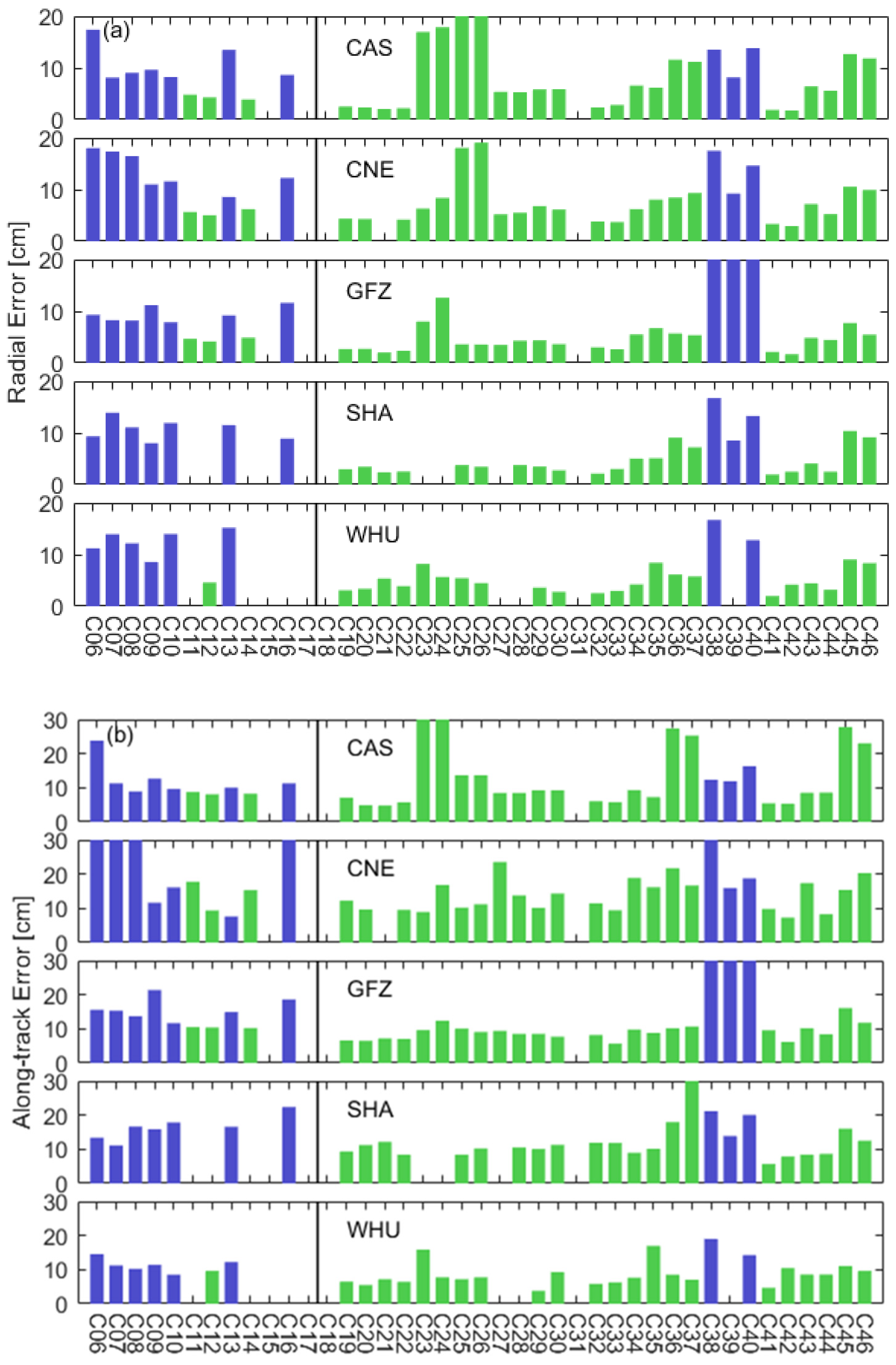
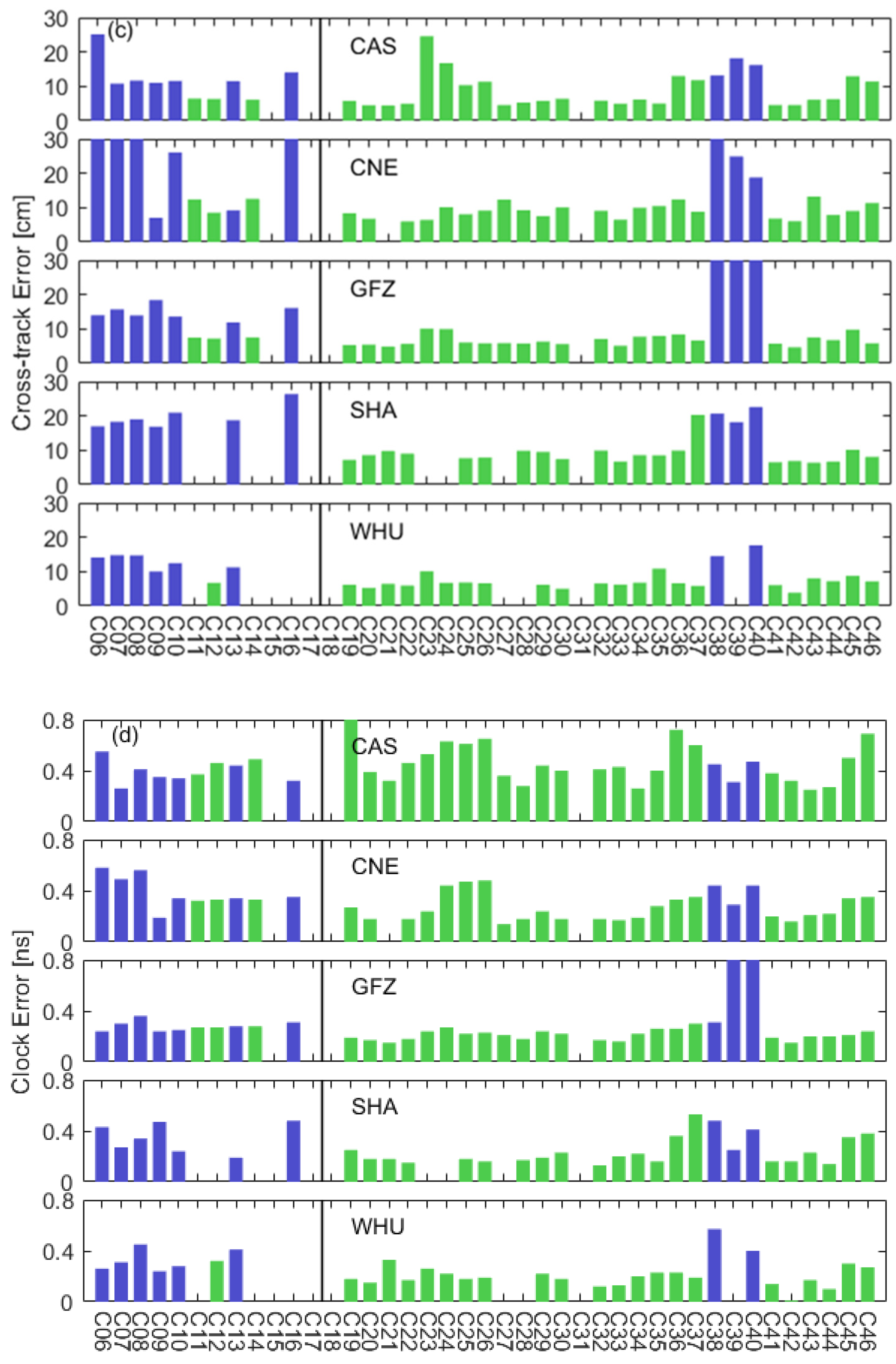
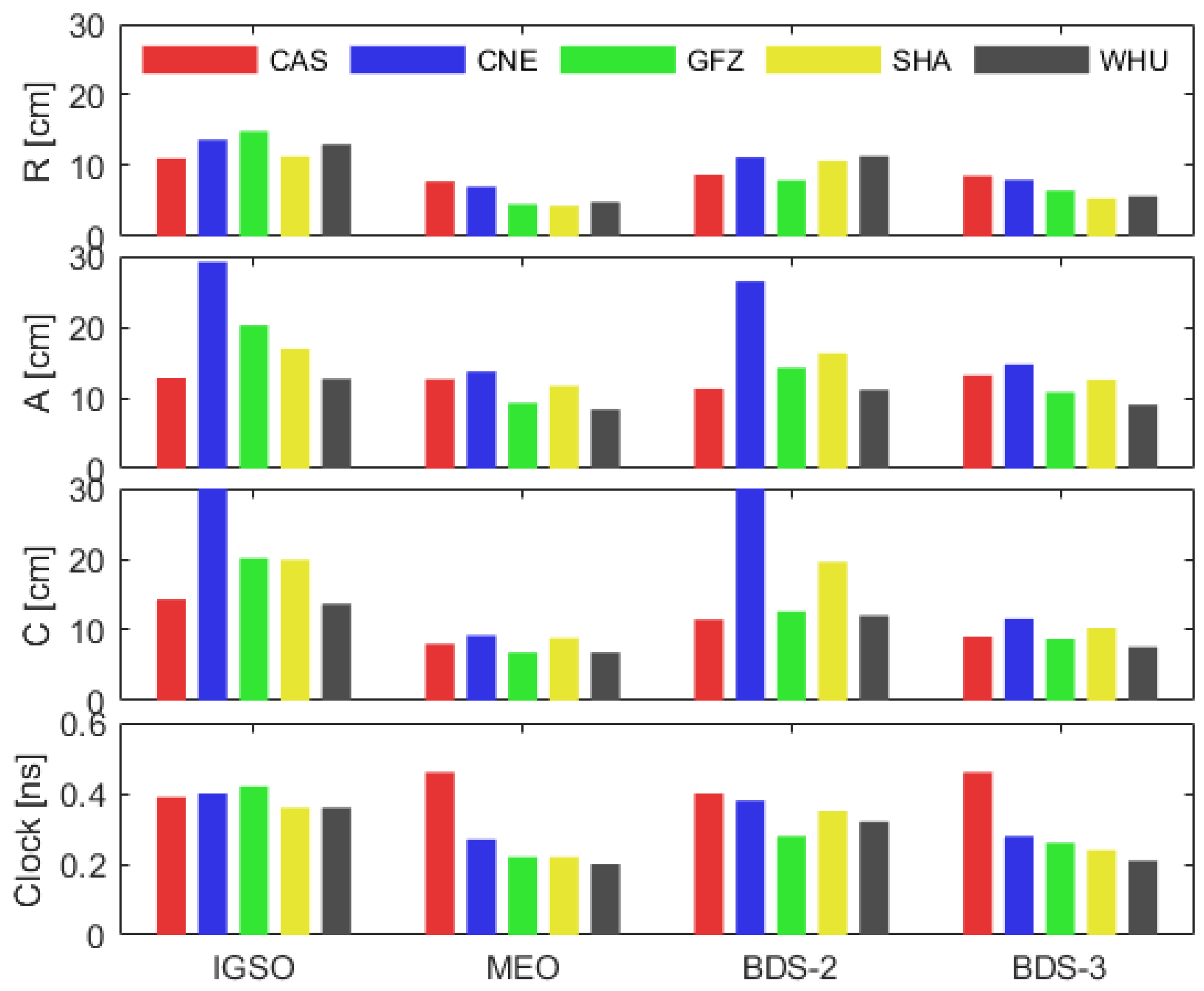
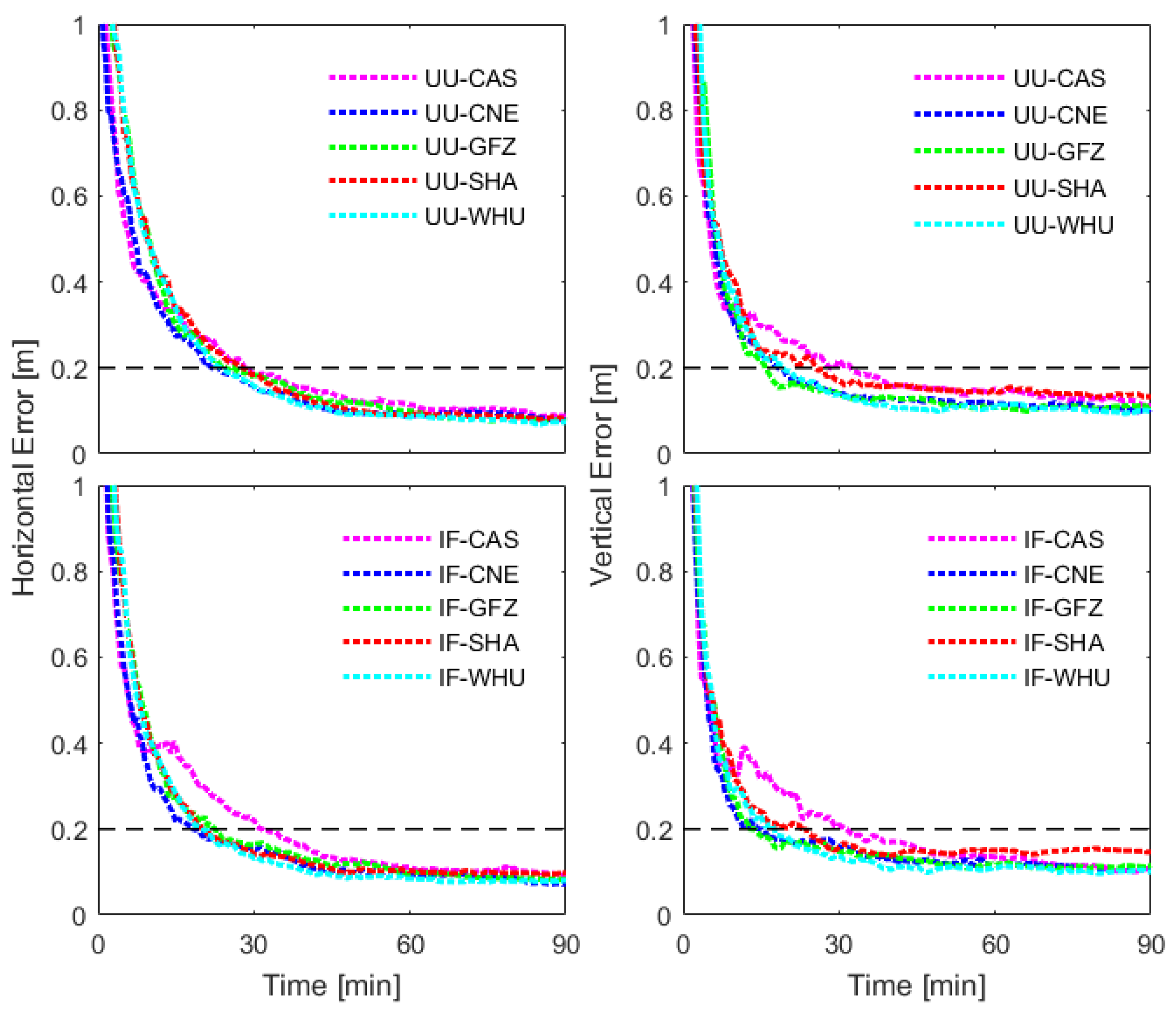

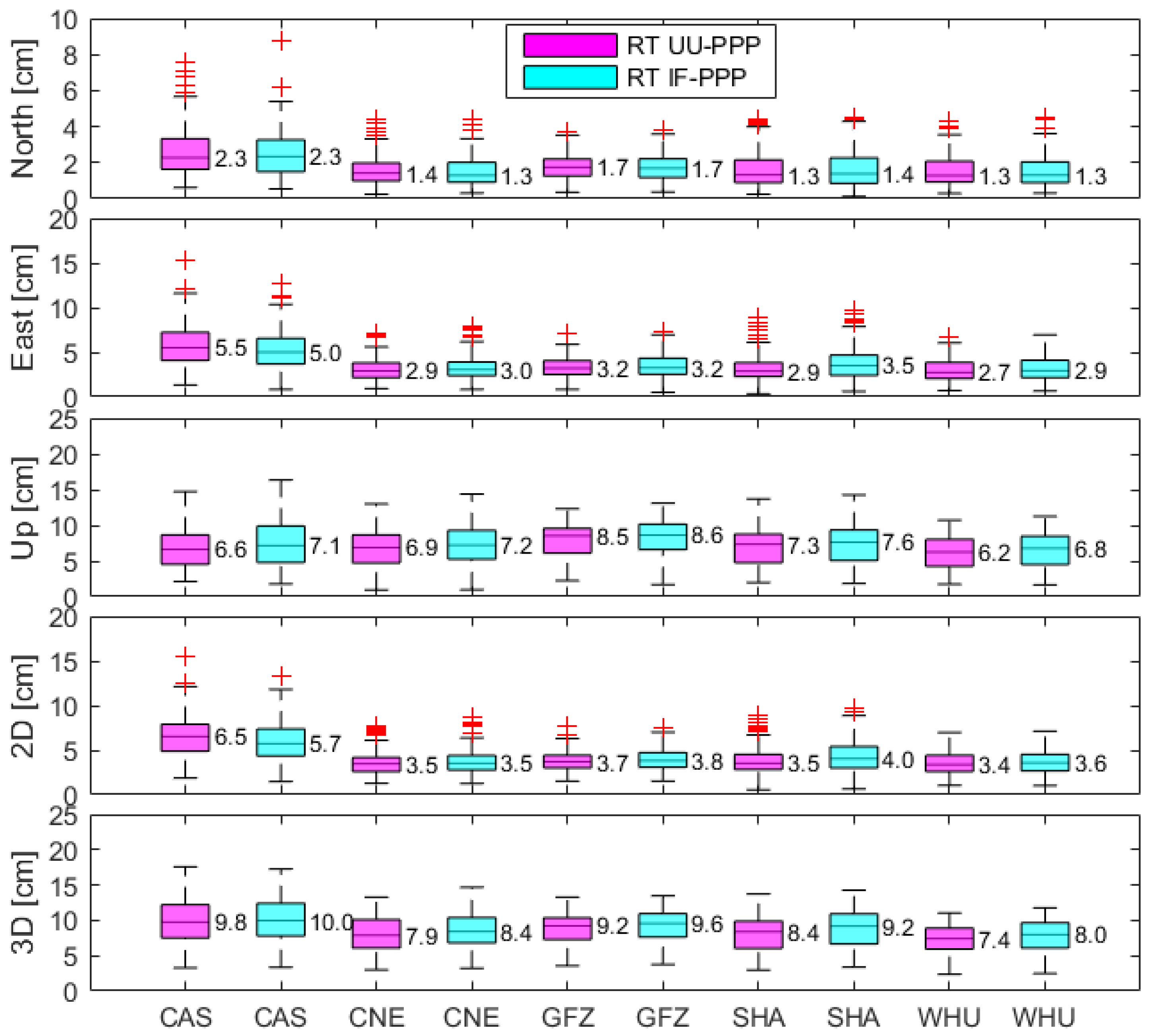


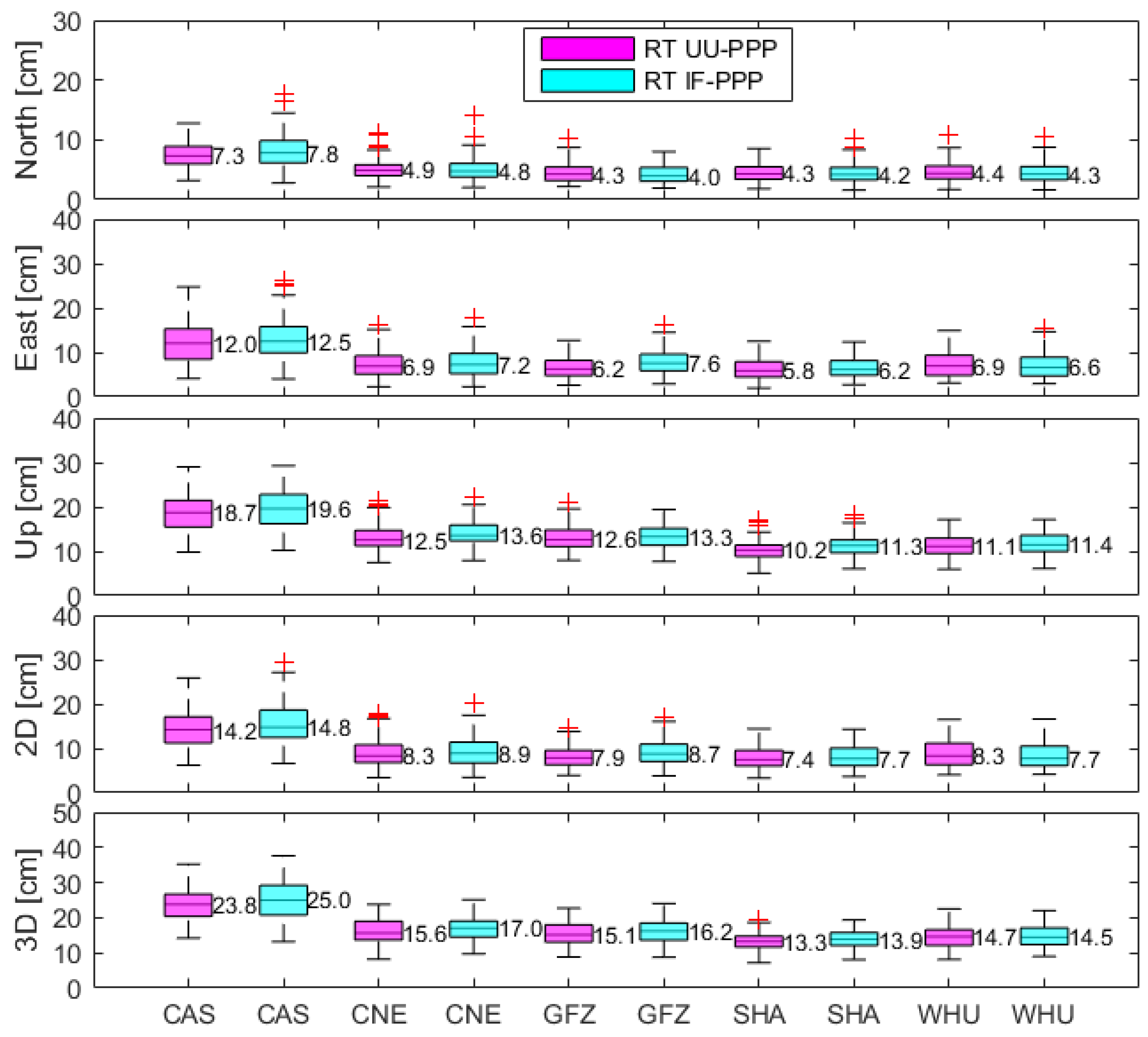
| ACs | Mount Point | Update Interval (Orbit/Clock) | Number of BDS Satellites | Missing BDS Satellites |
|---|---|---|---|---|
| CAS (Chinese Academy of Sciences) | SSRA00CAS1 | 5 s/5 s | 37 | \ |
| CNES (Centre National d’Etudes Spatiales) | SSRA00CNE0 | 5 s/5 s | 36 | C21 |
| GFZ (Deutsches GeoForschungsZentrum) | SSRA00GFZ0 | 5 s/5 s | 37 | \ |
| SHAO (Shanghai Astronomical Observatory) | SSRA01SHA0 | 30 s/30 s | 31 | C11–12, C14, C23–24, C27 |
| WHU (Wuhan University) | SSRA00WHU0 | 5 s/5 s | 31 | C11, C14, C16, C27–28, C39 |
| Items | Processing Strategies |
|---|---|
| Elevation cutoff angle | 7° |
| Satellite orbits and clocks | Broadcast ephemeris [25] + SSR corrections |
| Satellites DCB | SSR code bias |
| PCO and phase center variation (PCV) | Corrected with ATX file (igs14_2233.atx) |
| Tropospheric delay | Corrected by GPT2w + SAAS + VMF (Dry component) and estimated as random-walk noise (Wet component) [20] |
| Ionospheric delay | Corrected by CNES RT-VTEC products and estimated as random-walk noise [16] |
| Estimator | Kalman filter |
| Receiver coordinates and clocks | Estimated as white noise |
| ISB | Estimated as random-walk noise [20] |
| Phase ambiguities | Estimated as float solution |
| Component | CAS | CNE | GFZ | SHA | WHU |
|---|---|---|---|---|---|
| Horizontal | −10.9 | 15.4 | 8.7 | 36.6 | 17.1 |
| Vertical | 1.6 | 19.4 | 14.3 | 10.9 | 8.3 |
| Component | CAS | CNE | GFZ | SHA | WHU |
|---|---|---|---|---|---|
| Horizontal | −14.0 | 0.0 | 2.6 | 12.5 | 5.6 |
| Vertical | 7.0 | 4.2 | 1.2 | 3.9 | 8.8 |
| 3D | 2.0 | 6.0 | 4.2 | 8.7 | 7.5 |
| Component | CAS | CNE | GFZ | SHA | WHU |
|---|---|---|---|---|---|
| Horizontal | 31.7 | 20.3 | −0.9 | 1.9 | 6.4 |
| Vertical | 22.9 | 1.2 | 1.7 | 7.0 | 0.0 |
| Component | CAS | CNE | GFZ | SHA | WHU |
|---|---|---|---|---|---|
| 2D | 4.1 | 6.7 | 9.2 | 3.9 | −7.8 |
| Up | 4.6 | 8.1 | 5.3 | 9.7 | 2.6 |
| 3D | 4.8 | 8.2 | 6.8 | 4.3 | −1.4 |
Disclaimer/Publisher’s Note: The statements, opinions and data contained in all publications are solely those of the individual author(s) and contributor(s) and not of MDPI and/or the editor(s). MDPI and/or the editor(s) disclaim responsibility for any injury to people or property resulting from any ideas, methods, instructions or products referred to in the content. |
© 2024 by the authors. Licensee MDPI, Basel, Switzerland. This article is an open access article distributed under the terms and conditions of the Creative Commons Attribution (CC BY) license (https://creativecommons.org/licenses/by/4.0/).
Share and Cite
Wang, A.; Zhang, Y.; Chen, J.; Wang, H.; Luo, T.; Gong, M.; Liu, Q. Investigating the Global Performance of the BDS-2 and BDS-3 Joint Real-Time Undifferenced and Uncombined Precise Point Positioning Using RTS Products from Different Analysis Centers. Remote Sens. 2024, 16, 788. https://doi.org/10.3390/rs16050788
Wang A, Zhang Y, Chen J, Wang H, Luo T, Gong M, Liu Q. Investigating the Global Performance of the BDS-2 and BDS-3 Joint Real-Time Undifferenced and Uncombined Precise Point Positioning Using RTS Products from Different Analysis Centers. Remote Sensing. 2024; 16(5):788. https://doi.org/10.3390/rs16050788
Chicago/Turabian StyleWang, Ahao, Yize Zhang, Junping Chen, Hu Wang, Tianning Luo, Mingyou Gong, and Quanpeng Liu. 2024. "Investigating the Global Performance of the BDS-2 and BDS-3 Joint Real-Time Undifferenced and Uncombined Precise Point Positioning Using RTS Products from Different Analysis Centers" Remote Sensing 16, no. 5: 788. https://doi.org/10.3390/rs16050788
APA StyleWang, A., Zhang, Y., Chen, J., Wang, H., Luo, T., Gong, M., & Liu, Q. (2024). Investigating the Global Performance of the BDS-2 and BDS-3 Joint Real-Time Undifferenced and Uncombined Precise Point Positioning Using RTS Products from Different Analysis Centers. Remote Sensing, 16(5), 788. https://doi.org/10.3390/rs16050788









